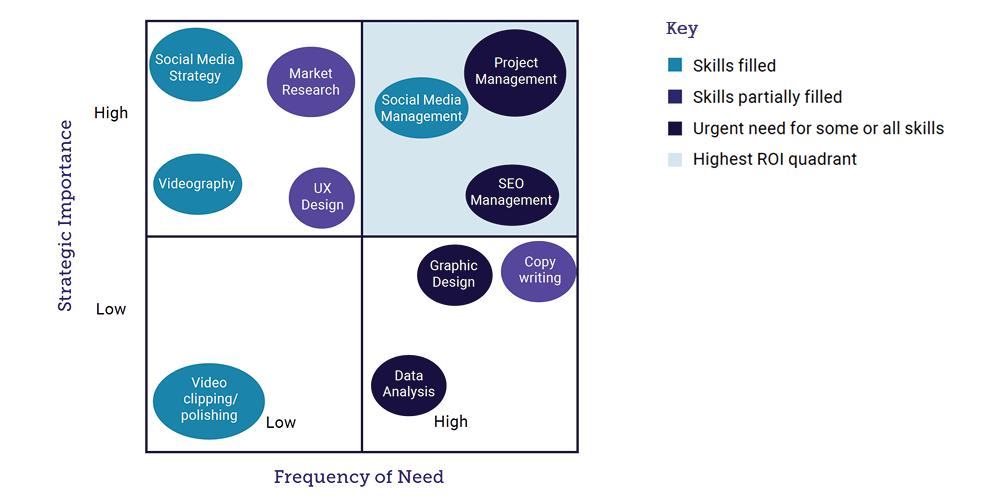Skills Assessment: The Foundation of a Direct Sourcing Business Case

- A direct sourcing program is part of an optimized workforce comprised of some portion of full-time employees and independents.
- Obtaining a buy-in (and budget) for a program starts with a business case, which starts with a hiring report and skills assessment.
- As the foundation of your direct sourcing business case, this assessment will offer a clear view of where to focus the program.
The benefits of a direct sourcing program to engage independent professionals can be compelling for an enterprise. Among the pluses, the ability to engage contractors without going through a third party can save costs and improve talent quality. Maintenance of a talent network of independent professionals can improve the re-engagement of high-value talent and minimize contractor churn. This can also increase your organization’s visibility in the market as a Client of Choice for highly skilled workers that intend to only work as independent contractors.
A direct sourcing program is part of an optimized workforce comprised of some portion of full-time employees and independents. As such, the program must be strategic in nature and focused on skills critical to business success that are best suited to contractors. In short, the business importance and the high repetition of the role being hired will determine where an organization should start their direct sourcing program build-out.
Obtaining a buy-in (and budget) for a program starts with a business case. And the business case for a direct sourcing program starts with a hiring report and skills assessment.
Data Collection in Three Steps
A direct sourcing program skills assessment’s goal is identifying strategic skills best suited to independent talent. These three steps will give you the data needed to create the assessment:
- Make an inventory of all skills hired as Full-time or contingent labor
- Look at current budgeting and where skills will be needed in the next 30-60-90 + days
- Once you have this data you can start to position the skills in a two by two that will show the business importance and the frequency of hire
Preparing the Skills Assessment
Using your data collection results, the skills assessment will be an accurate picture of the current state of the enterprise, the areas where skills are needed, and the recommended distribution of skills across the blended workforce. The assessment should include:
- Skills ranked strategically (e.g., a number rank with the highest number representing business-critical skills)
- Status of skills in the current talent population (e.g. a green-yellow-red chart that highlights absent [red] or below-target [yellow] skills)
- Assignment of skills across the workforce (i.e., skills that are best based in the employee population, which are best residing in the contractor community, and which need to be in both)
Portraying this information visually can be highly effective. One way to do this is through a Magic Quadrant that places skills relative to strategic importance, frequency of need, and status. This example is for a marketing department.

As the foundation of your direct sourcing business case, this assessment will offer a clear view of where to focus the program. The top right square of the quadrant, representing high importance and frequently hired skills, will produce the highest ROI.
You Don’t Need to Boil the Ocean
Performing a skills assessment across the whole enterprise can be challenging and highly time-consuming. Starting with a business unit, department, or team can be more effective, especially if your business case proposes one or more direct sourcing pilots up front. You’ll get needed data and produce your assessment more quickly—and can use these results to gain traction to create more assessments in the company.
Last Word: Gain Value and Efficiency with a Partner
A highly effective approach to creating your direct sourcing skills assessment is the use of a third-party expert. Such a partner can:
- Help quickly identify needed skills
- Facilitate workshops with managers, conduct interviews with leadership, and efficiently review documentation to create your skills inventory
- Help you determine the skills of highest importance and frequency
Make sure the partner you engage understands a skills-based organizational view and has direct sourcing experience in their portfolio. As an outside stakeholder who brings insight and best practices to the table, you can gain valuable insight and high-quality results in a timely manner.
MBO Partners can help you throughout your direct sourcing journey. We can help your organization begin through a workshop with key stakeholders. Contact us to get started.
Categories
Subscribe to the Insights blog to get weekly insights on the next way of working
Source, engage, and manage high value talent through MBO marketplace
Learn more about MBO
Learn how to start, run and grow your business with expert insights from MBO Partners
Learn how to find, manage and retain top-tier independent talent for your independent workforce.
MBO Partners publishes influential reports, cited by government and other major media outlets.
Research and tools designed to uncover insights and develop groundbreaking solutions.


